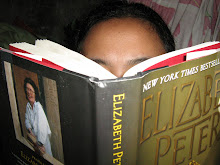
We saw golden bangles, rings, and necklaces, earrings, tiaras and studs, belts, bowls, cups and hilts of weapons. I was fascinated when I saw the burial masks, with stylized features engraved in the gold. I thought: forget ancient Egypt, it turns out the Philippines has its own! Aside from the burial masks, there were also "orifice coverings", shaped like the eyes, the nose and the mouth. I guess if the dead couldn't afford a whole mask, they could just go for the important parts! Whew! Move over, King Tut!
Aside from the burial masks, I was also fascinated with the Kinnari, a small vessel shaped like a mythical woman-bird, who appeared to be holding some kind of jug. Her eyes looked serenely out at the people who had come to see her. There was also the binibini, an anthropomorphic plaque depicting the head of a lady with what seemed like an elaborate hairdo or headdress. I also drooled over a cuff or wrist ornament, as wide as a sleeve and intricately worked, so that the gold mesh was like lace. The information on it said it weighed 204 grams. Heavy! There were also earrings so big and so heavy that we all wondered how the owner could possibly have worn it without getting his or her ears torn. My personal favorite, however, was a beautiful belt (I know someone's snickering while reading this!). Catalog No. 81.5175, weighing 575.1g, measuring 68.2x49 cm, circa 10th - 13th century. It was made of fine mesh, with a zigzag design running along its length, and two golden plaques ornamented with granules of gold painstakingly arranged into stylized designs. Oh, I could have stood there and stared at it forever!
Then, there was the piece de resistance: the Upavita or Sacred Thread, weighing almost 4 kilos (heaa-veee!), strikingly similar to one depicted in the 16th century Boxer Codex, said to be the earliest description of the people of the Philippines in a Western language. a copy of which can be found in the exhibit. The Upavita was supposed to be draped around the neck then attached to the wrist. Wow, the person who wore that must've been pretty strong!What was striking about these artifacts was that they seemed so Pinoy to me. There were at least two necklaces or bracelets that were woven banig-style: take four flat strips of gold and weave a fifth one back and forth across it, the way we used to weave banana-leaf or coconut-leaf ornaments. The Upavita itself reminded me of the legs of a modern armchair made of nito because it had the same basket-weave technique. Some of the other items were decorated simply by poking holes in the gold to create a lacy pattern. The tiaras were created by cutting a sort of fringe in a strip of gold, then bending them back and forth to make a crown-like design.
Seeing the exhibit made all of us walk a little taller and prouder. We had always read about the treasures of other lands, like Egypt and Troy; now we know that we have our own! Mabuhay ang Pilipinas!
Special thanks to our boss, Mr. Gaspar A. Vibal, for making this wonderful experience possible for us.











